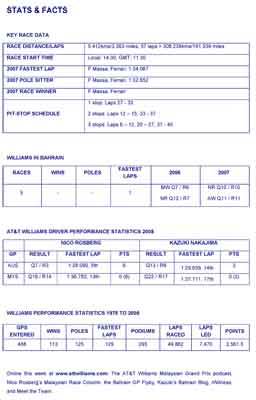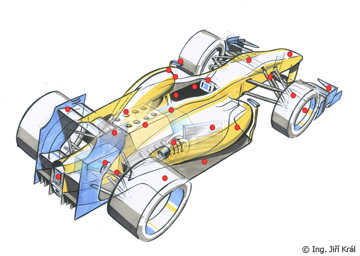TiskovÃĄ informace - WilliamsF1 (EN)
Miroslav SanytrÃĄk | 4.4.08 | Aktuality
BAHRAIN GRAND PRIX PREVIEW
MONDAY 31 MARCH, 2008
Formula One moves from the Far East to the Middle East this week as Bahrainâs state-of-the-art Sakhir circuit hosts the third round of the 2008 Formula One World Championship and the last of the season-opening long haul races this Sunday, 6th April.
Located on the only island within the Persian Gulf, and thirty kilometres from the stateâs capital, Manama, the Sakhir track cuts right through the desert and is therefore one of the most unique, but challenging, venues on the calendar. After not scoring points in Malaysia, the AT&T Williams team travel to the fifth Bahrain Grand Prix in pursuit of a more competitive weekend of racing.
Nico Rosberg
Iâm really looking forward to this weekend. Bahrain is one of my favourite tracks
and Iâve had some great results there. Last year, we didnât get the best out of
the weekend, but weâve learnt from that and weâll be better this year, and we will
come back stronger after the struggles in Malaysia. The track and asphalt
surface of the Sakhir circuit are more suited to our car so we shouldnât
encounter the same problems again.
As a whole, itâs been quite an extreme start to the season. We had a very
strong start and then a bit of a down, but thatâs the way it is in racing and you
just have to get on with it. Weâve already learnt a lot from the past two races
and we will make progress going into these next few races. Iâll be at home in
between Malaysia and Bahrain so I can relax and do some training.
Kazuki Nakajima
Weâve had a bit of a mixed start to our season. The race in Melbourne was
obviously very good, and then Malaysia was not so good for us. Weâve learnt
lessons from both Grands Prix and I"ll be doing my best to help get the team
back to where we think we should be.
Personally, I think that the track in Bahrain is really good. Itâs a great circuit for
racing because there are a few opportunities to overtake, so I"m looking forward
to having a good race there.
Sam Michael, Technical Director, Williams F1
Set against the desert, Bahrainâs track is normally quite dusty and itâs always
hot. Ambient temperatures hover around the mid 30s and the chance of rainfall
is low. The trackâs layout is dominated by long straights and slow and medium
speed corners. There is only really one high speed section, but it doesnât bear
much influence over the set-up direction of the car.
Bridgestone will bring the medium and soft tyre compounds to this race. Most
teams opt for a two stop pitstop strategy, although a one stop option has been
employed there before.
We have two targets for the Bahrain Grand Prix; firstly to improve upon the
reliability which caused us problems during practice at the previous two races
and, secondly, to build on our Constructorsâ position by scoring more points.
Bahrain International Circuit
One of the most unique destinations on the calendar, Bahrainâs imposing
desert backdrop significantly influences track conditions and car set-up over
the Grand Prix weekend at Sakhir. Regional winds intermittently blow desert
sands onto the 5.412km circuit which inevitably pose certain challenges for all
but the leading driver as they pursue their counterparts and their cars are
blasted with air infused with damaging sand particles. The sandy conditions
therefore dictate the need for heavy duty air filters to prevent the air cooling
inlets becoming blocked. An essential requirement, but one which mustnât
compromise aerodynamic efficiency. Grip levels are another casualty of the
sand and can be considerably reduced when it settles on the track making all
but the racing line dangerously slippery.
The track is a complex mix of 15 slow and medium speed corners connected
by three high speed straights, the fastest of which will see the cars peak at
320kph at the end of the pit straight going into turn one. With the lowest
cornering speed registered at just above 100kph at Sakhirâs turn five, and
taken in first gear, the number of extreme braking events is high so brake
preservation is paramount. Due to the long, high speed stretches, each lap will
demand a full throttle percentage of 62%; combined with the braking, cooling
and sand variables, engine reliability will be a considerable factor in the raceâs
outcome. A circuit built to house 50,000 spectators, the third race of the season
will undoubtedly deliver another exciting Formula One Grand Prix.
|





